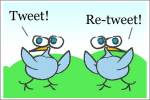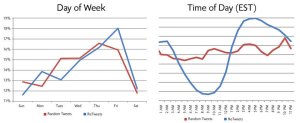Other Twitter Topics: Twitter BackChannel for Presenters Navigating the Approval Maze Social Media: Not Just for Kids Email The Scoopdog Team
+++++++++++++++++++++++++++++++++++++++++++++++++++++++++
 (Read time = 3-4 minutes) One of the first investigations that marketers tackle when entering the social media game is likely to be Twitter. Near the top of the Twitter investigation will likely be re-tweets (RTs): their value, characteristics, and strategies for gaining traction as will impact message persistence. For those less Twitter savvy: a retweet is when someone re-posts a Twitter message that they received from somebody else. Re-tweets are usually preceded by an “RT” or “Retweeting” and then the source person’s name in an @ reply format to assign credit (akin to footnoting the original source.
(Read time = 3-4 minutes) One of the first investigations that marketers tackle when entering the social media game is likely to be Twitter. Near the top of the Twitter investigation will likely be re-tweets (RTs): their value, characteristics, and strategies for gaining traction as will impact message persistence. For those less Twitter savvy: a retweet is when someone re-posts a Twitter message that they received from somebody else. Re-tweets are usually preceded by an “RT” or “Retweeting” and then the source person’s name in an @ reply format to assign credit (akin to footnoting the original source.
So why the fuss to understand RTs? In simple terms, “authority” and the ability to sustain market messaging/buzz. Being cited as an information source reinforces thought leadership and brand importance; gaining any level of viral messaging further impacts the marketing campaign. But is it science… or just artful prose?
Consider the audience size: Twitter June visitors wwide – 44.5 million (comScore). FYI, cS only counts traffic to Twitter.com; since many users instead use Twitter apps to consume/publish, Twitter’s total audience is significantly larger. cS does provide a consistent measure, however, of Twitter growth. Even when some research indicates that ~40% Twitter traffic is “pointless babble” ( Pear Analytics study), the potential audience/traffic is large, indeed.
For a real-time Twitter traffic counter, GigaTweet estimates that the number of tweets recently passed the 5 Billion mark
Update 11/11: related video here; thanx Muneer.
Studies and Research
Microsoft employs social media research scientists: Here, Danah Boyd and Gilad Lotan (MS) joining with Cornell researcher Scott Golder to investigate the conversational aspects of retweeting: (draft paper on RT here) , scheduled to be published early in 2010.
Another social media research scientist, Dan Zarrella (bio here) pulls apart re-tweet trends and success analytics. His data presentation is posted at SlideShare here. Zarrella spent nine months analyzing ~5 million tweets and 40 million retweets. He investigated when posts occurred, wording, link inclusion (or not), and much more.
Briefly, some thought starters for consideration:
1. Leave Room: Write your original tweet shy of the 140 limit to both allow for the (RT @ Twitter User Name) addition, and avoid requiring that the pass-along author re-write your original text. While challenging, an original character count of 115-120 should provide sufficient room to encourage a viral re-tweet.
2. Timing matters: 4pm Friday EST! I didn’t see that Zarrella’s data factored for content-type (ie B2B v. Consumer, etc.) but certainly the charting should give marketers pause; A trend beginning to appear are marketers tracking their own experiences and building their own benchmarks, by industry target, as to most effective times/days for tweets and re-tweets.

3. Include links: Tweets that included additional content sources were 3x more likely to be passed along. Interestingly, the research also noted that the shorter the URL link out, the more likely a retweet would occur.
4. Choose your words wisely: “Please”, “retweet”, “check out”, “blog” and “new blog post” all appeared in Zarrella’s most frequently used word list. In the least retweetable category were a number of “ing” verbs (going, watching, listening…”). Takeaway: idle chit-chat, slang, and over sharing does little to prompt message persistence.
5. Original content: Well, duh… original content is way more poular than news previously circulated.
6. Grammar: Tweets that rely heavily on the use of nouns and 3rd-person verbs (what we typically refer to as headline-style) were more likely to be retweeted
Monitor and Benchmark
The diversity in audience target segments, social media objectives and marketing goals demand that most B2B marketers establish their own benchmarks over time. Tools are beginning to appear (think Tweetmeme, Retweet.com, etc.) but ROI for social media remains hotly debated. By experimenting with approach, content and campaigns, individual benchmarks can evolve. Would welcome reader insights and experiences as additions to the conversation.
*****************************************************************************
Welcome! If you like/are interested in B2B Marketing, the Agency-Client Relationship discussion and/or other Marcom mysteries, ![]() please subscribe to my RSS feed.
please subscribe to my RSS feed.

11/10/2009 at 1:40 pm
may i retweet this???
11/10/2009 at 1:41 pm
by all means, please…
11/10/2009 at 11:21 pm
Hey there,
Great stuff, I guess great minds think alike 🙂 since i made a similar post on my blog!
Anyhow I just thought your readers might find this interesting since it is a very similar post and is called nine scientifically proven ways to get retweeted.
http://netadvertisingsuccess.com/174/scientifically-proven-ways-retwitted-twitter/
Its a quick video talking about similar things mentioned up there in your post.
Regards,
Muneer
11/12/2009 at 3:13 am
This is very good. Nice research.
11/19/2009 at 2:52 pm
Great stuff! That’s some interesting data there. Brian Solis also had an interesting article on retweets recently and is worth checking out: http://www.briansolis.com/2009/10/the-science-of-retweets-on-twitter/
12/21/2009 at 8:43 am
[…] (image empruntée ici) […]